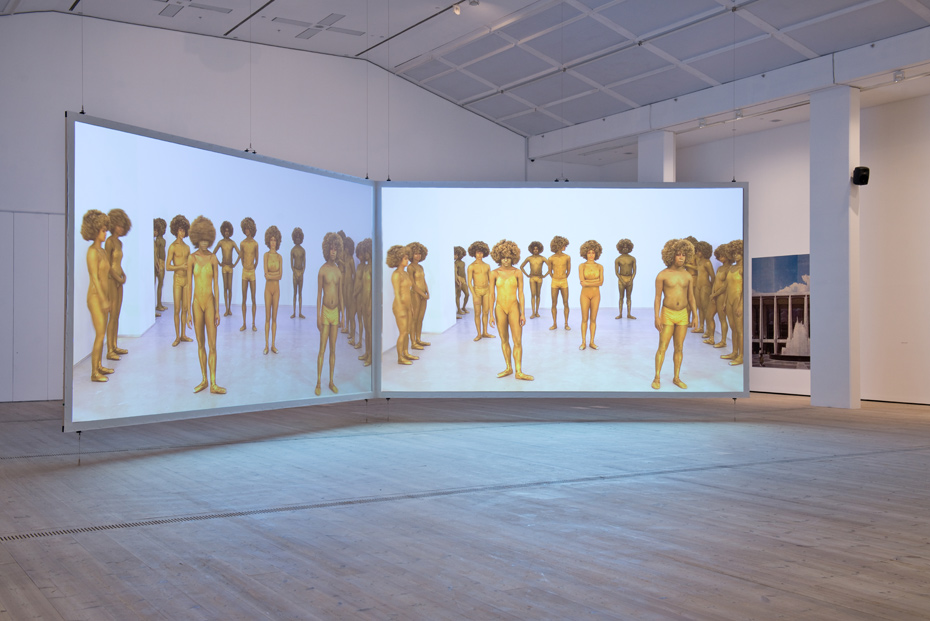The artist’s first European retrospective at the BALTIC recounts the most significant moments of her life, says Millie Walton
Photo: Colin Davison © 2014 BALTIC Centre for Contemporary Art
When she was eleven years old, artist Lorna Simpson performed at a ballet recital in New York wearing a wig and gold body paint. It has remained one of her most pertinent memories, not because she laments a lost career path but because she recalls stepping onto stage and being suddenly struck by the realisation that she would ‘prefer to be in the audience.’
This is revealing of the voyeuristic thread that runs throughout Simpson’s art, repeated in her 2010 video ‘Momentum’. Played on two giant screens, the video dominates the wide, open gallery space and is mesmerising to watch, as the eye is continually drawn back to the spinning, gold-clad figures. The dancers’ giant afros and glistening bodies are contrasted by the quietness of the blank white background and the un-moving focus of the camera lens. We watch as they form lines against the wall, looking bored, waiting for the dancing to begin. Then the twirling begins. The choreography is unspectacular, resulting in a feeling that comes close to disappointment and yet, it’s also hugely compelling, exposing the flatness behind the glamorous façade and humanising the performers by showing the mundane.
Alongside the video, a series of swirling, gold brush strokes line a portion of the gallery’s walls mimicking the fluid motion of the dancers and capturing a moment of creative spontaneity. A similar burst of energy is conveyed by Simpson’s collection of black and white photographs of female heads with colourful, painted hairstyles. Like much of the artist’s work it’s consciously playful and amusing whilst also addressing more serious issues of identity and race. The women’s billowing hair comes to express suppressed personality and questions culturally accepted notions of womanhood, beauty and fashion. This is a theme that runs throughout Simpson’s work as she explores the identity of the African American female.
The lower-level gallery space offers a very different side to Simpson’s work, presenting a more subdued and sombre atmosphere. The pieces are all black and white and incorporate text and images to create open-ended narratives that simultaneously illuminate and confuse the viewing experience.

for Contemporary Art
In ‘Stereo Styles’ (1988), Simpson again returns to women’s hairstyles, photographing the same woman’s hair from the back with accompanying text panels proposing adjectives such as ‘Daring’, ‘Sensible’ or ‘Boyish’. With her head turned away from the camera, the figure becomes a representation of femininity and a point of intrigue.
The figure in Simpson’s beautiful photograph, ‘Waterbearer’ (1986) is similarly unidentifiable; her back is turned as she pours water from two receptacles. The whiteness of her dress is startling against the black backdrop and evokes traditional perceptions of purity. The text below recounts the words of Phillis Wheatley, a slave who became a poet and the first black female author to be published in America: “She saw him disappear by the river. They asked her to tell what happened, only to discount her memory.”
The female focus again meditates on social perceptions of gender and reveals the insignificance of memory in the face of authority.
However, the most moving work in the exhibition is Simpson’s 2004 video installation, ‘Cloudscape’. Screened in a small dark, alcove at the back of the lowest gallery space, the video shows a single, spot-lit man whistling a hymn popularised by African American slaves during the late seventeenth and early eighteenth century. The man (recently deceased artist and musician Terry Adkins) is gradually enveloped in a thick fog so that eventually he disappears completely from view. His bird-like song eerily continues, until the fog diminishes and we return again to the opening scene. It’s intensely surreal and otherworldly, leaving you, as with most of Simpson’s work, feeling overwhelmed.
Lorna Simpson is showing at Baltic Centre for Contemporary Art, Gateshead until 22 June 2014. Visited the exhibition? Leave us your thoughts below, or click for more info HERE




